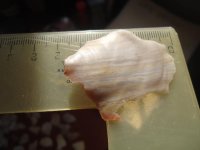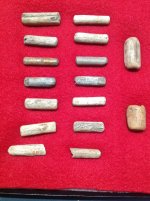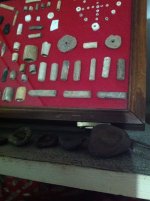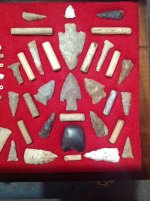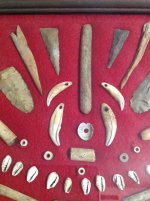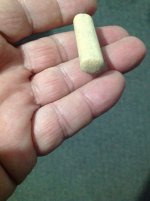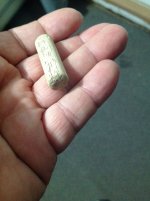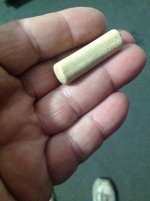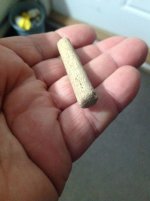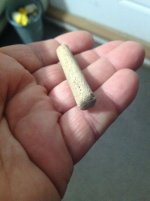Grim Reaper has the best privately owned flintknapping punch collection on the intern
In case anyone is interested in mysteries, Grim Reaper owns the best flintknapping punch collection that I have ever seen on the entire internet. The only collections I have seen that rival his, are in museum collections. If you want to see the tools used by prehistoric Americans, in fashioning stone points, you can study his collection. Also, other people here may have similar tools in their collections, though they may think that they are "gaming pieces", or some other named item.
The gaming piece idea actually appears to stem from an observation made by a single archaeologist, during the early 1900's, who thought that the tools look like "pegs used in a game of chance". What this archaeologist did not seem to examine was the lifecycle of the tools, and the associations of the tools, with chipped stone products. Later, the "game piece" description seems to have continued in literature, in some quarters.
The reason I say that these tools are "mysteries" is because modern flintknappers between the 1960's, and at least 2010, were unable to explain how these tools were used in the industries that they were associated with. In fact, as I found out in 2010, trying to suggest that maybe these tools were even flintknapping tools is enough to get a person blacklisted, since the idea goes against decades of flintknapper's dogma.
This year, in 2018, I have finally resolved how the tools were used, though the line of evidence used to understand the tool's use came from a very unexpected place. And, unless a person is familiar with the other line of evidence, it is quite possible that it would be impossible for a person - even a modern knapper - to guess at the tool's use. But, when one looks at the differing morphologies of finished prehistoric points, the evidence may already be there, even in the finished points, themselves.
Anyway, I am collaborating with some archaeologists and working on writing about the evidence that was rejected by modern flintknapper's. Anyway, here are some of Grim Reaper's tools, found in a late historic site. These tools are no different then those found in sites from the advent of the archaic era. And, the tools persisted right into the historic era.
Grim Reaper's tools
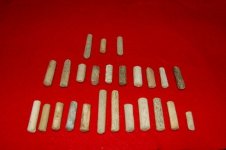
Here are similar flintknapping tools from Belize:
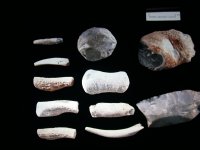
Here are some from the Goldcamp site:
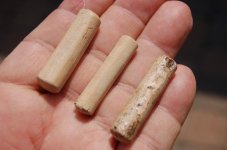
Here are some from Madisonville:
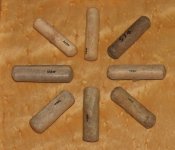
Tools that are found run the gamut from new to used, depending on context. I believe Shafer says that at Belize they seemed to be wore down until they were an inch and a half long, and then discarded.
Okay, here is a mockup tool that is five centimeters long:
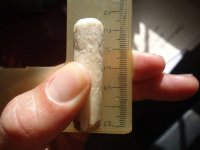
This tool was used to remove a blade that is almost as long:
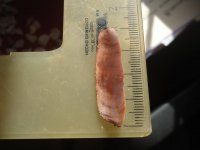
Back of blade:
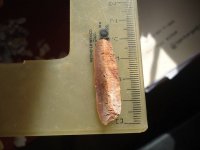
The tool was also used to remove this flake which is 5 cm long. Note: One of the contentions of modern flintknappers is that "punches make short flakes". In this case, the flake is as long as the punch. And, unlike the blade, it has a slight bend to it, which means that it is arcing over the face of the stone:
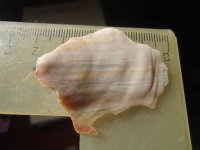
Note the distinctive half moon platform remnant that is 5mm wide, by maybe 2mm thick
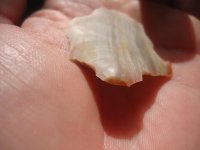
Note the series of flakes, blades, with tiny lipped platform remnants. The tiny lipped platform remnants are a trait of the flaker, and flaking technology.
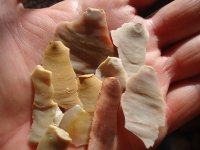
If you have these small antler cylinder tools in your collection, they are really important. Do not let flintknappers tell you otherwise. These tools have a history of continuous use, since the advent of the archaic era, and may have even been used during the paleoindian era.
In case anyone is interested in mysteries, Grim Reaper owns the best flintknapping punch collection that I have ever seen on the entire internet. The only collections I have seen that rival his, are in museum collections. If you want to see the tools used by prehistoric Americans, in fashioning stone points, you can study his collection. Also, other people here may have similar tools in their collections, though they may think that they are "gaming pieces", or some other named item.
The gaming piece idea actually appears to stem from an observation made by a single archaeologist, during the early 1900's, who thought that the tools look like "pegs used in a game of chance". What this archaeologist did not seem to examine was the lifecycle of the tools, and the associations of the tools, with chipped stone products. Later, the "game piece" description seems to have continued in literature, in some quarters.
The reason I say that these tools are "mysteries" is because modern flintknappers between the 1960's, and at least 2010, were unable to explain how these tools were used in the industries that they were associated with. In fact, as I found out in 2010, trying to suggest that maybe these tools were even flintknapping tools is enough to get a person blacklisted, since the idea goes against decades of flintknapper's dogma.
This year, in 2018, I have finally resolved how the tools were used, though the line of evidence used to understand the tool's use came from a very unexpected place. And, unless a person is familiar with the other line of evidence, it is quite possible that it would be impossible for a person - even a modern knapper - to guess at the tool's use. But, when one looks at the differing morphologies of finished prehistoric points, the evidence may already be there, even in the finished points, themselves.
Anyway, I am collaborating with some archaeologists and working on writing about the evidence that was rejected by modern flintknapper's. Anyway, here are some of Grim Reaper's tools, found in a late historic site. These tools are no different then those found in sites from the advent of the archaic era. And, the tools persisted right into the historic era.
Grim Reaper's tools

Here are similar flintknapping tools from Belize:

Here are some from the Goldcamp site:

Here are some from Madisonville:

Tools that are found run the gamut from new to used, depending on context. I believe Shafer says that at Belize they seemed to be wore down until they were an inch and a half long, and then discarded.
Okay, here is a mockup tool that is five centimeters long:

This tool was used to remove a blade that is almost as long:

Back of blade:

The tool was also used to remove this flake which is 5 cm long. Note: One of the contentions of modern flintknappers is that "punches make short flakes". In this case, the flake is as long as the punch. And, unlike the blade, it has a slight bend to it, which means that it is arcing over the face of the stone:

Note the distinctive half moon platform remnant that is 5mm wide, by maybe 2mm thick

Note the series of flakes, blades, with tiny lipped platform remnants. The tiny lipped platform remnants are a trait of the flaker, and flaking technology.

If you have these small antler cylinder tools in your collection, they are really important. Do not let flintknappers tell you otherwise. These tools have a history of continuous use, since the advent of the archaic era, and may have even been used during the paleoindian era.
Attachments
Last edited:
Upvote
0


